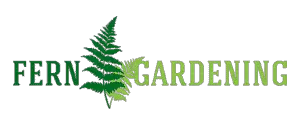There are some limiting factors in gardening that are very challenging to overcome. One example is the pH of your soil, which is largely a result of your local geology. Ferns will generally grow well in acid or neutral conditions, but if you instead have alkaline soil in your yard, what are your planting options?
Several varieties of ferns thrive under alkaline conditions, including Asplenium species, Polystichum species, Cystopteris species and Polypodium species ferns. Some popular and beautiful examples are the Hart’s tongue ferns, Maidenhair spleenwort, Soft and Hard shield ferns, Southern polypody, and bladder ferns. Many other fern varieties can tolerate soil with high pH, and a high lime content should not discourage you from choosing ferns as part of your planting scheme.
Alkaline soil is caused by the presence of sodium carbonate or sodium bicarbonate. These minerals naturally form in geological areas with a high content of limestone or chalk (hence why alkaline soil is sometimes called “lime”). In such areas, it is also likely that the local water supply will be hard water, meaning high levels of these minerals will be dissolved within it. Watering your yard from a hose connected to the mains supply could therefore further increase soil pH.
Alkaline soils are often thought to be difficult for gardening, because the soil composition is usually heavy clay that has poor structure, but there are plenty of plants – including ferns – that can grow very well under these conditions. Here are some of the best:
Ferns that grow well under alkaline conditions
A family of ferns that grow especially well under alkaline conditions are the Asplenium species ferns. This group includes the Hart’s tongue fern, Bird’s nest fern and the Maidenhair spleenwort.
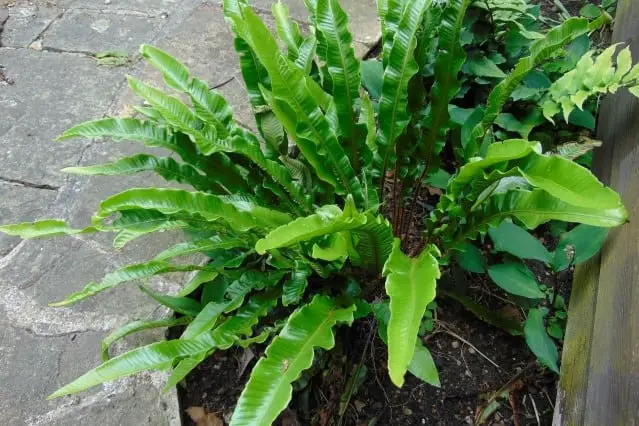
Hart’s tongue fern
- Asplenium scolopendrium
- Evergreen
- Prefers partial or full shade
- Height: up to 0.5 m
- Soil: alkaline or neutral. Moist, well drained.
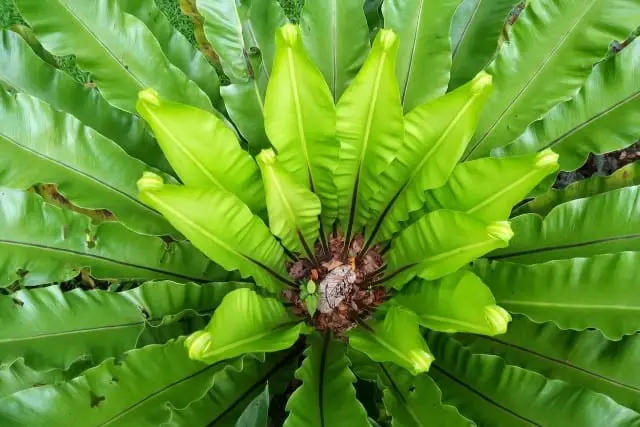
Bird’s nest fern
- Asplenium nidus
- Evergreen
- Partial or full shade
- Height: up to 1 m
- Soil: acid or neutral. Moist, well-drained.
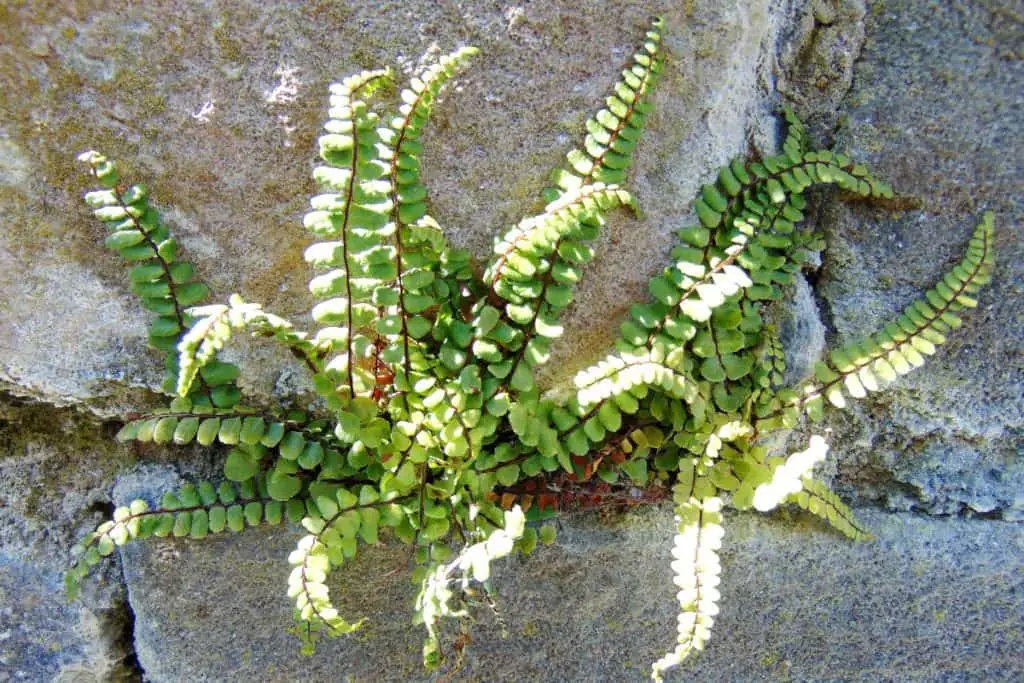
Maidenhair spleenwort
- Asplenium trichomanes
- Evergreen
- Full or partial shade
- Height: up to 0.3 m
- Soil: neutral or alkaline. Moist, well-drained.
The Asplenium ferns also have a wide range of unusual and interesting cultivars and varieties, which vary in the shape and style of the fronds – such as the Asplenium scolopendrium ‘Crispum’ and ‘Fimbriatum’ and ‘Ramosum’ groups, which have creased or crinkled edges to the broad, fleshy fronds of the classic Hart’s tongue fern.
Another family of alkaline-loving ferns are the Polystichum species or shield ferns. These have a more traditional fern-like appearance, with delicate fronds decorated with many pinnae that often have a serrated edge. Examples of common and well-regarded Polystichum ferns include the Christmas fern, Soft shield fern, Hard shield fern and Western sword fern.
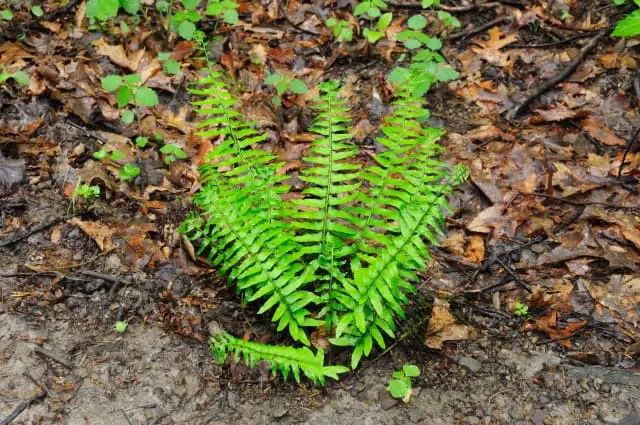
Christmas fern
- Polystichum acrostichoides
- Evergreen
- Partial shade
- Height: up to 1 m
- Soil: acid, neutral or alkaline. Moist, well-drained.
As with the Asplenium ferns, there are many interesting varieties and cultivars of shield ferns, particularly for the soft shield fern, Polystichum seriferum. Especially noteworthy are the ‘Grandiceps’ and ‘Herrenhausen’ cultivars, which have strikingly crested and complex frond shapes.
Polypodium species ferns are also happy in alkaline soil, with common polypody being the archetypal example.
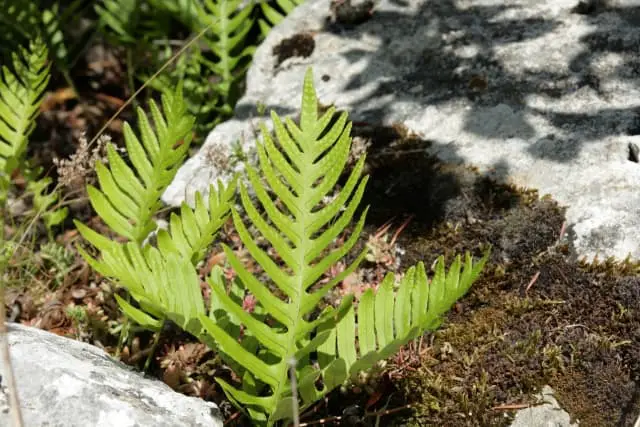
Common polypody
- Polypodium vulgare
- Evergreen
- Partial shade or full sun
- Height: up to 0.5 m
- Soil: Neutral or alkaline. Moist, well-drained.
There are many other varieties, including Southern polypody (which again has a dizzying array of cultivars of every shape and size), Licorice fern, and Intermediate polypody.
Other good options are the bladder ferns, or Cystopteris species ferns. This genus also grows well on alkaline soil, but they are not so widely popular as other varieties. The Brittle bladder fern and Dickie’s bladder ferns are beautiful plants, but they are also deciduous and lose their foliage early in fall, meaning they will have most impact in the spring.
Beyond these key species, a final mention should go to Limestone polypody (Gymnocarpium robertanium), which, as the name suggests, grows happily in limestone scree and lime-rich soils.
Ferns that grow in any pH
In addition to ferns that have a particular affinity for alkaline soil, there are even more species that are pretty indifferent to soil pH, and will grow successfully in acid, neutral or alkaline conditions. These generalists can tolerate a range of soil conditions, but there will be some variation in the vigor and speed with which they grow. Unfortunately, the only way to know for sure how well individual examples of this class of ferns will do in your own soil, is to try them and find out.
The Dryopteris species ferns tend to have this flexibility, meaning lime-rich soil is no barrier to growing the highly popular and beautiful Autumn, King and Sunset ferns, and the common Male fern.
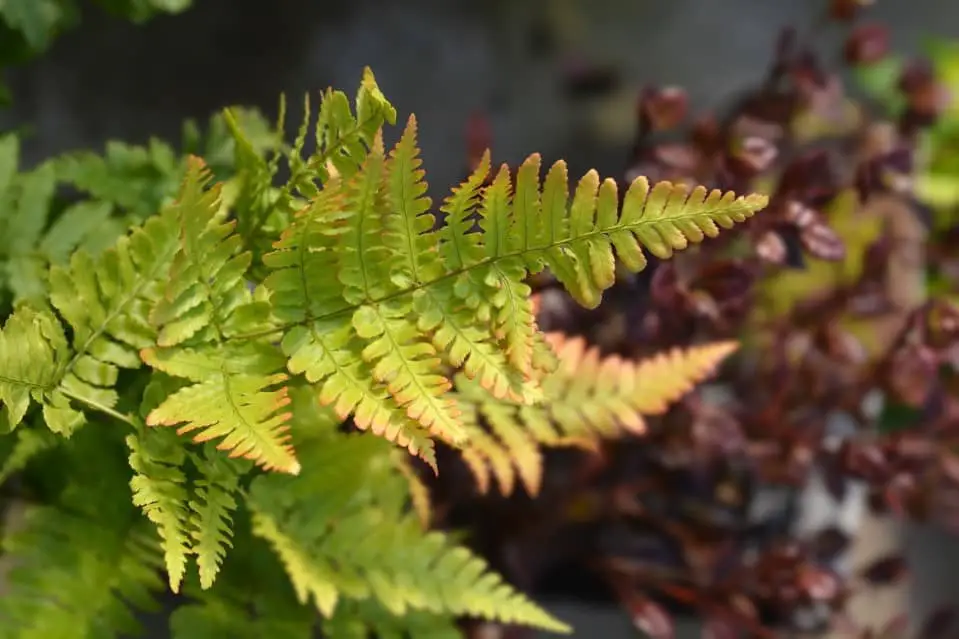
Autumn fern
- Dryopteris erythrosora
- Semi-evergreen
- Full or partial shade, and full sun
- Height: up to 1 m
- Soil: tolerant of most pH and drainage conditions.
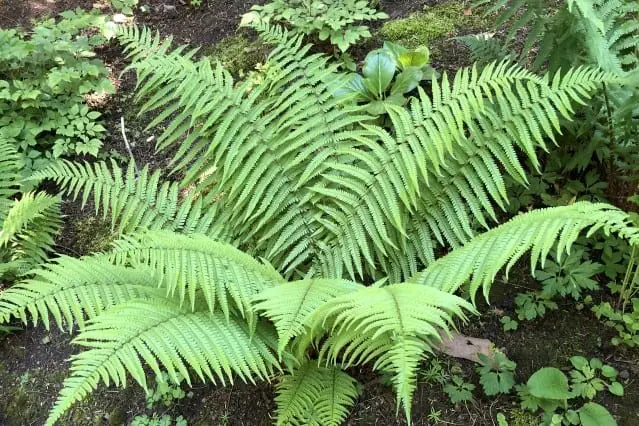
King fern
- Dryopteris affinis
- Semi-evergreen
- Shade, partial or full sun
- Height: up to 1.5 m
- Soil: acid, neutral or alkaline. Moist, well-drained.
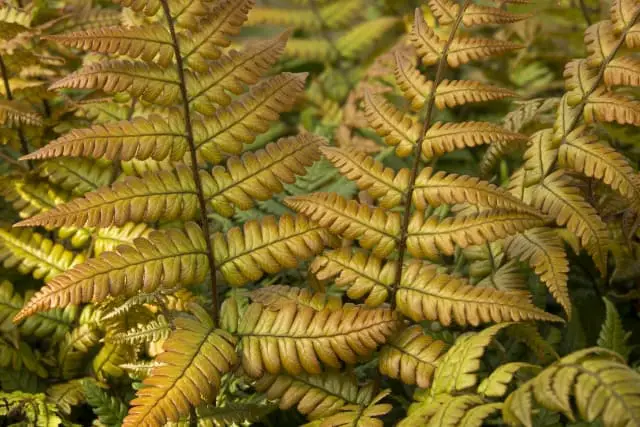
Sunset fern
- Dryopteris lepidopoda
- Semi-evergreen
- Full or partial shade
- Height: up to 1 m
- Soil: acid or neutral. Moist, well-drained.
Similarly, the range of Adiantum or Maidenhair ferns, can grow well in acid, neutral or alkaline soils.
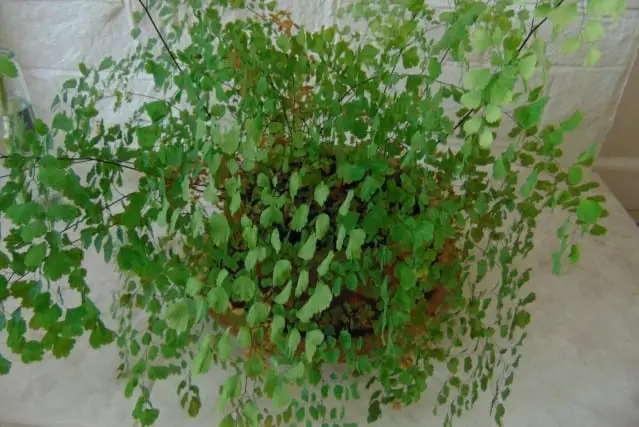
Maidenhair fern
- Adiantum raddianum
- Evergreen
- Partial shade
- Height: up to 0.5 m
- Soil: neutral or alkaline. Moist, well-drained.
Finally, many species of Athyrium, or Lady ferns, also grow in a range of soil pH values, and so could succeed in alkaline conditions. This includes the very popular Japanese painted ferns.
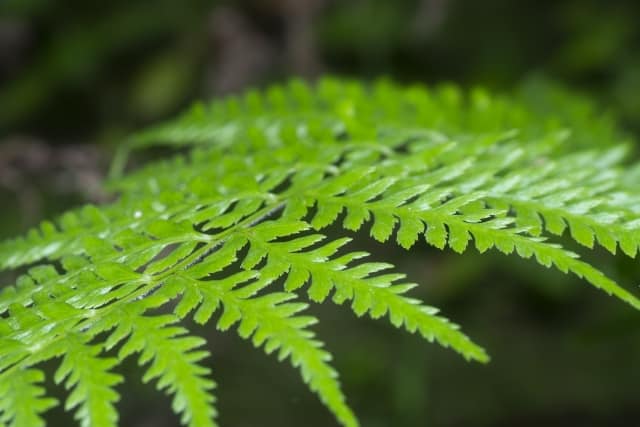
Lady fern
- Athyrium filix-femina
- Deciduous
- Prefers partial or full shade
- Height: up to 1 m
- Soil: acid or neutral. Moist, poor drainage tolerated.
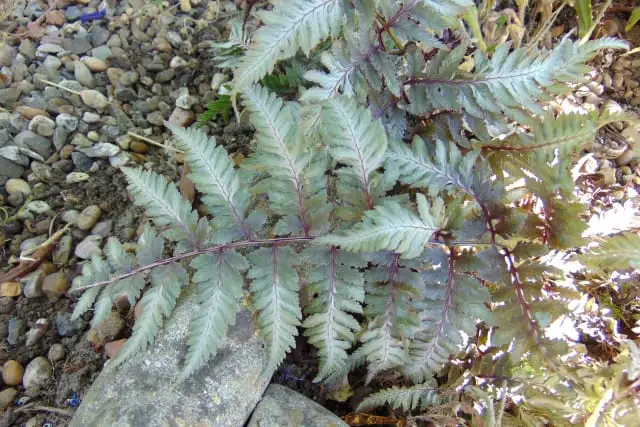
Japanese painted fern
- Athyrium niponicum
- Deciduous
- Prefers partial shade
- Height: up to 0.5 m
- Soil: acid, neutral or alkaline. Moist, well-drained.
A note of caution here, though, is that some growers report problems with some cultivars of the Athyrium niponicum ferns in hard water areas, suggesting they are more vulnerable to alkaline conditions than the native Lady fern from which they are derived. This helps illustrate the principle that experimenting is the only surefire way to know how sensitive a specific variety of fern is to lime-rich soils.
Ferns to avoid in alkaline soil
While there is a wide range of choice amongst ferns for alkaline soils, there are some species that definitely prefer acid conditions.
Many of the Osmunda species ferns, including the Cinnamon and Interrupted ferns, favor acid soil.

Cinnamon fern
- Osmunda cinnamomea
- Deciduous
- Prefers partial shade
- Height: up to 1.5 m
- Soil: acid. Moist, poor drainage tolerated.
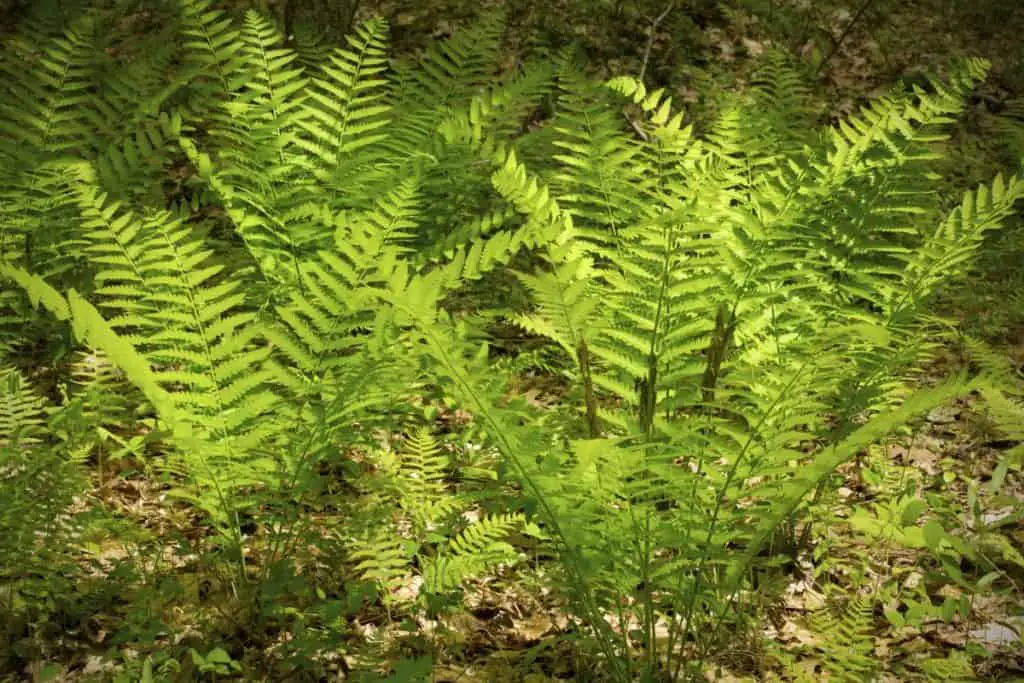
Interrupted fern
- Osmunda claytoniana
- Deciduous
- Prefers partial shade
- Height: up to 1 m
- Soil: acid. Moist, poor drainage tolerated.
Blechnum and Woodwardia species are also happiest in acid conditions, meaning the many varieties of Hard and Chain ferns are also likely to struggle in lime-rich soils.
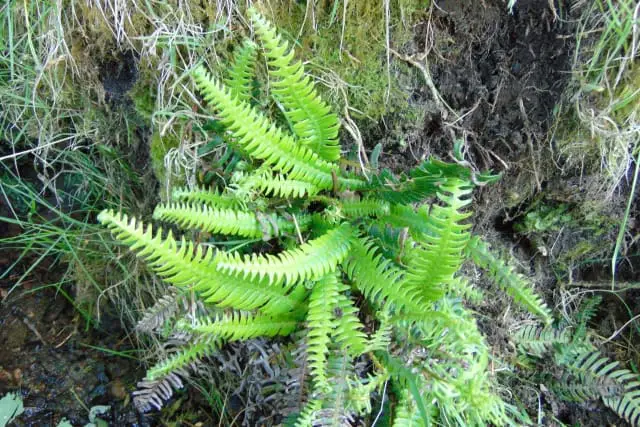
Hard fern
- Blechnum spicant
- Evergreen
- Prefers partial or full shade
- Height: up to 0.5 m
- Soil: acid or neutral. Moist, poor-drainage tolerated.

Oriental chain fern
- Woodwardia orientalis
- Evergreen
- Prefers partial shade
- Height: up to 1.5 m
- Soil: acid or neutral. Moist, tolerates poor drainage.
This does impose some restrictions on your planting scheme, but it is also possible to work around the limitations of alkaline soil if you really want to include acid-loving ferns in your garden.
How to grow acid-loving ferns in alkaline conditions
The simplest solution to a conflict between your local soil conditions and your desire to grow acid-loving ferns is to use pots and containers to control the potting mix that your specimen grows in. By the use of an ericaceous (acid) compost you can isolate the fern from the soil, and so work around the limitations of your local geology.
This principle can be scaled up to a whole bed or border, if you are willing to do the groundwork needed to alter the natural composition of a lime-rich soil. By excavating the ground, adding a gravel or rubble layer (for drainage and to prevent direct mixing with underlying clay soils) and then back-filling with topsoil or compost that is acid, you can engineer a bed suitable for acid-loving plants. This will work best if you edge the bed with a barrier of some sort to prevent rainwater washing alkaline minerals into the new soil from the surrounding landscape.
It is also possible to directly treat your own soil with conditioners that will lower the pH. Aluminum sulfate is the commonest and easiest treatment which is safe and easy to use, and works within a few months. It is possible to use sulfuric acid to speed up the process, but this is hazardous and not recommended for home use. Alternatively, sulfur can be used as a more economical method, but will take longer to bring about the same drop in pH. The exact treatment regime will depend on the starting pH of the soil, but all good suppliers will provide detailed instructions on dosing and treatment schedules.
Finally, if you do invest the time and money needed to create a controlled pH planting space, remember to only water the plants with captured rainwater. If your local mains water is rich in lime minerals, you will inadvertently make the soil more alkaline with every watering.
Although ferns favor acid or neutral soil as a rule of thumb there are still many, many options available for those gardeners with lime-rich soils. Ferns are so varied, adaptable and robust as a family of plants that there is ample scope for including them in any environment, regardless of local geology and soil chemistry.
